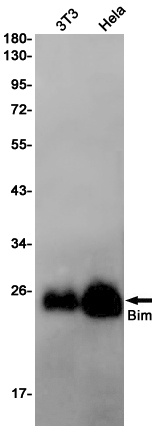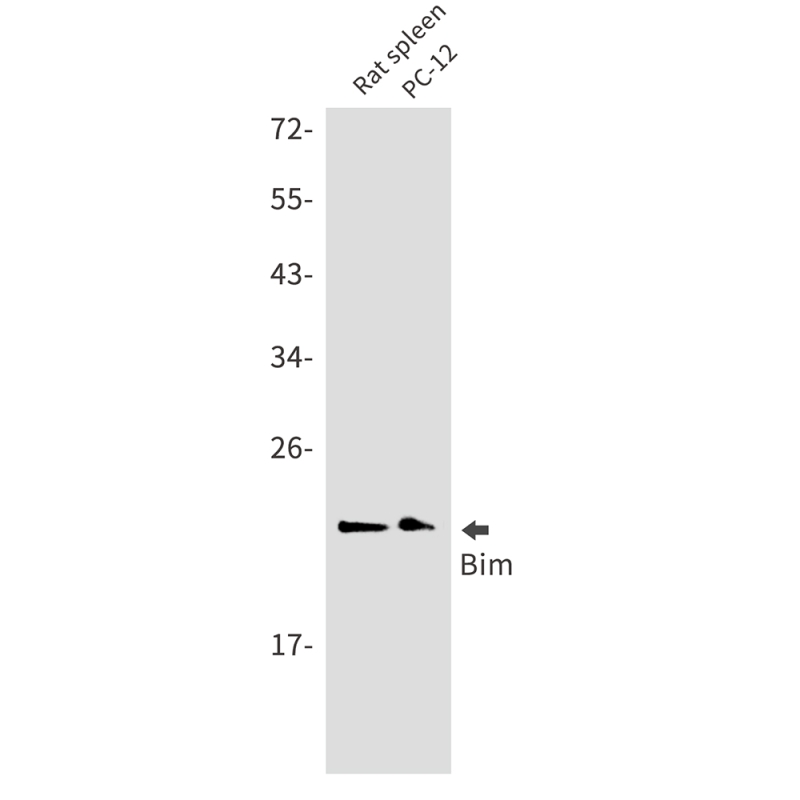

| WB | 咨询技术 | Human,Mouse,Rat |
| IF | 1/20 | Human,Mouse,Rat |
| IHC | 1/50-1/100 | Human,Mouse,Rat |
| ICC | 1/50-1/200 | Human,Mouse,Rat |
| FCM | 咨询技术 | Human,Mouse,Rat |
| Elisa | 咨询技术 | Human,Mouse,Rat |
| Aliases | BAM; BIM; BOD; BimL; BimS; BimEL; BIM-beta6; BIM-beta7; BIM-alpha6; BCL2L11 |
| Entrez GeneID | 10018 |
| WB Predicted band size | Calculated MW: 22 kDa; Observed MW: 22 kDa |
| Host/Isotype | Rabbit IgG |
| Antibody Type | Primary antibody |
| Storage | Store at 4°C short term. Aliquot and store at -20°C long term. Avoid freeze/thaw cycles. |
| Species Reactivity | Human,Mouse,Rat |
| Immunogen | A synthetic peptide of human Bim |
| Formulation | Purified antibody in TBS with 0.05% sodium azide,0.05%BSA and 50% glycerol. |
+ +
以下是关于Bim抗体的3-4篇参考文献,按文献名称、作者及摘要内容简要概括:
1. **文献名称**:*"The role of Bim in apoptosis and its regulation by survival signals"*
**作者**:O'Connor, L., et al.
**摘要**:探讨Bim蛋白在细胞凋亡中的核心作用,揭示生长因子通过调控Bim的稳定性影响细胞存活。研究通过特异性Bim抗体进行Western blot分析,验证其在多种细胞系中的表达动态。
2. **文献名称**:*"BH3-only proteins: Orchestrators of apoptosis"*
**作者**:Huang, D.C., Strasser, A.
**摘要**:综述BH3-only蛋白家族(含Bim)在凋亡信号通路中的调控机制,提及使用Bim特异性抗体在小鼠模型中检测蛋白表达,关联其与疾病进展的关系。
3. **文献名称**:*"Selective inhibition of BCL-XL over BCL-2 enhances tumor cell apoptosis"*
**作者**:Tao, Z., et al.
**摘要**:研究靶向BCL-XL的药物促癌凋亡机制,利用Bim抗体通过免疫沉淀验证Bim与BCL-XL的相互作用,强调其在凋亡通路中的功能重要性。
4. **文献名称**:*"Development and validation of a novel Bim antibody for immunohistochemical analysis in lung cancer"*
**作者**:Chen, Y., et al.
**摘要**:报道一种新型Bim抗体的开发与验证,证实其在肺癌组织免疫组化中的应用效果,并分析Bim表达水平与患者预后的相关性。
这些文献涵盖了Bim抗体的功能研究、实验工具应用及特异性抗体开发,适用于凋亡机制探索或实验方法参考。
Bim (Bcl-2-interacting mediator of cell death) is a pro-apoptotic protein belonging to the BH3-only subgroup of the Bcl-2 family. It plays a critical role in initiating mitochondrial apoptosis by neutralizing anti-apoptotic Bcl-2 proteins (e.g., Bcl-2. Bcl-xL) or directly activating pro-apoptotic effectors like Bax/Bak. Bim is regulated transcriptionally and post-translationally, with its activity influenced by growth factors, stress signals, and therapeutic agents. Dysregulation of Bim expression or function is linked to cancer progression, autoimmune diseases, and neurodegenerative disorders.
Bim antibodies are essential tools for detecting and quantifying Bim protein levels in research. They are widely used in techniques like Western blotting, immunohistochemistry, and flow cytometry to study apoptosis mechanisms, drug responses, and disease pathogenesis. Specific Bim antibodies can distinguish between its isoforms (BimS, BimL, BimEL) or phosphorylation states, providing insights into context-dependent regulatory mechanisms. In cancer research, Bim antibodies help evaluate tumor cell sensitivity to targeted therapies (e.g., tyrosine kinase inhibitors) and chemotherapeutics, as Bim upregulation often correlates with treatment efficacy. Their applications also extend to studying immune cell homeostasis and neuronal survival, underscoring Bim's broad relevance in cellular stress responses.
×